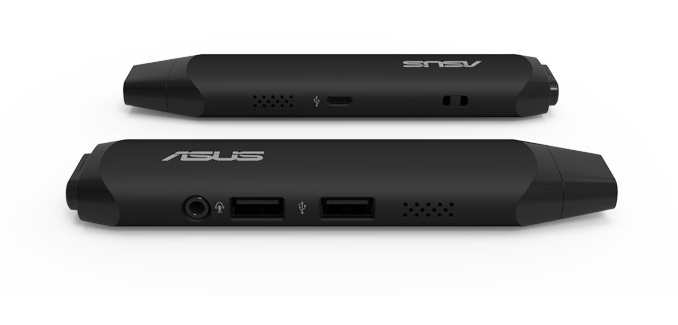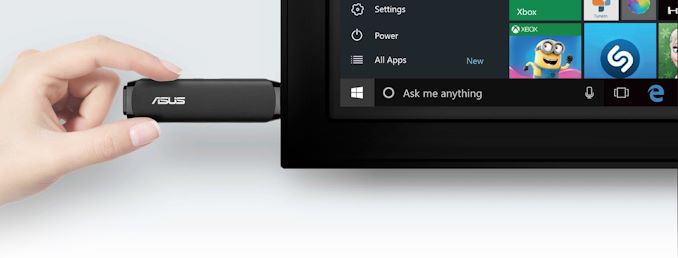ASUS Upgrades Compute Stick: The VivoStick TS10 Gets More RAM, Storage, & Windows 10 Pro
by Anton Shilov on February 19, 2020 7:00 PM EST- Posted in
- Desktop
- Systems
- Atom
- Asus
- Cherry Trail
- Compute Stick
- VivoStick

Intel’s Compute Stick, a self-contained PC-on-a-stick that could be used to transform any display into a PC, was an interesting concept when it was revealed several years ago. However it never really took off in the intervening years, due in part to limitations imposed by the form factor, leading to the chipmaker to abandon the project. Still, the Compute Stick did find a small but apparently loyal user base who remained interested in the niche solution, and so this week ASUS is introducing a new version of its VivoStick PC TS10 with more RAM and Windows 10 Pro.
First introduced back in 2017, the original ASUS VivoStick PC TS10 was based on Intel’s Atom x5-Z8350 SoC (Cherry Trail with 4 Airmont CPU cores), which was accompanied by 2 GB of LPDDR3-1600 memory as well as 32 GB of eMMC storage. The newly updated VivoStick PC TS10, model TS10-B174D, sticks with the same chassis and uses the same SoC, but it is now equipped with 4 GB of LPDDR3 memory as well as 64 GB of storage. Furthermore, the new unit also runs Microsoft’s Windows 10 Pro, replacing Windows 10 Home used in the original model.
Otherwise, the VivoStick is essentially unchanged from its earlier incarnation. The unit has two USB Type-A ports (2.0 & 3.0), a Micro USB connector for power, an combo audio jack, and an HDMI 1.4 connector for video out.
The original VivoStick TS10 with Windows 10 Home was designed primarily with consumer and SOHO applications in mind, and many retailers still sell it as a media streaming player that offers Windows 10 flexibility and can run loads of applications. But with the updated VivoStick TS10, ASUS seems to be broadening their niche just a bit, especially with access to Pro-focused features like Active Directory support and Microsoft Update for Business. Potentially, this means that ASUS can position the new VivoStick PCs differently and aim customers who need cheap miniature computers with business-class features and security.
So far, ASUS has introduced its revamped VivoStick PC TS10 in Japan and has not disclosed its pricing. All told, it is pretty strange for a PC maker to introduce an improved version of a three-year old product, so it will be interesting to see just what ASUS has in mind for their updated compute stick.
Related Reading:
- The Intel Compute Stick (Core m3-6Y30) Review
- The Intel Compute Stick (Cherry Trail) Review
- Intel Expands Compute Stick Family with Cherry Trail and Core M Models
Source: ASUS Japan (via Hermitage Akihabara)











35 Comments
View All Comments
S4Lee - Wednesday, February 19, 2020 - link
Meh... I don't really see too many use cases for this. For $25, I bought a cable that enables Dex on my Samsung Galaxy. Got the basic apps I need, and if I need a Win10 PC, I RDP into a VM. For a permanent install, I'd probably look to a PI 4 or an Intel NUC.Danvelopment - Wednesday, February 19, 2020 - link
Market is probably what we wanted them for (but never used them for because of Windows Home edition).Permanently turning dumb older meeting room displays into computers so that everyone needn't haul their laptops in and fark around with cables, discover that their new laptop doesn't have that output. Run out and get an adapter etc etc.
Office docs, maybe a website or two and it makes the room tidy and will always work.
Factoring in buying another Windows license meant it was uneconomical and so the idea was scrapped.
MASSAMKULABOX - Thursday, February 20, 2020 - link
W10 pro is only £100 ? emmc storage is not necesaarily slow . I've used it and noted speeds at 50% of a samsung SSD, so perfectly usable. But that Soc.. Good for presentations websites power point etc as long as you bring an air mouse. What could they do on a bigger power budget ?69369369 - Thursday, February 20, 2020 - link
Atom x5 in 2020 🤢damianrobertjones - Thursday, February 20, 2020 - link
"due in part to limitations imposed by the form factor" - I'd say that the 'main' reason would be price, or that 2Gb is awful for Windows. Oh... also the 32Gb which would be full within two months. Also the cpu. Pretty much everything. Intel had a few nice sticks.fazalmajid - Thursday, February 20, 2020 - link
I bought a similar machine from Azulle, with an Ethernet jack (unusual for this form factor), for $70 refurbished from NewEgg. I installed OpenBSD on it and it serves as a VPN server using OpenIKEd, and perfectly fine for that purpose.Cliff34 - Thursday, February 20, 2020 - link
Newbie question.. What if they stick a 8cx in the stick? Price points may be diff but performance should be better than atom?Tomatotech - Thursday, February 20, 2020 - link
Been looking at buying one of these to turn a spare monitor into a low cost office display - show a live schedule (on an excel spreadsheet!), and a couple of Chrome windows with other schedules and stats, all at the same time. Hopefully this new model means the older ASUS ones will be cheaper.Not sure if its up to the task - it would probably work out of the box, but I dont want to babysit it through windows updates every few months and have it run out of storage etc.
Tomatotech - Thursday, February 20, 2020 - link
Also not looking to spend more than around £100, so either a very cheap used PC on a stick, or a used Lenovo ThinkCentre, one of the tiny beasties.PeachNCream - Thursday, February 20, 2020 - link
Compared to my Bay Trail 11.6 inch laptop, this would be an improvement from a CPU perspective, but I find it hard to consider hardware like this with a 4GB RAM and 64GB storage limitation. That's one of the reasons I'm still sitting on my Bay Trail PC. It has a SO-DIMM slot with 8GB and I've fed it a 1TB SATA SSD which makes it comfortable to use from a storage and memory standpoint, though the GPU and CPU performance leave a lot to be desired.